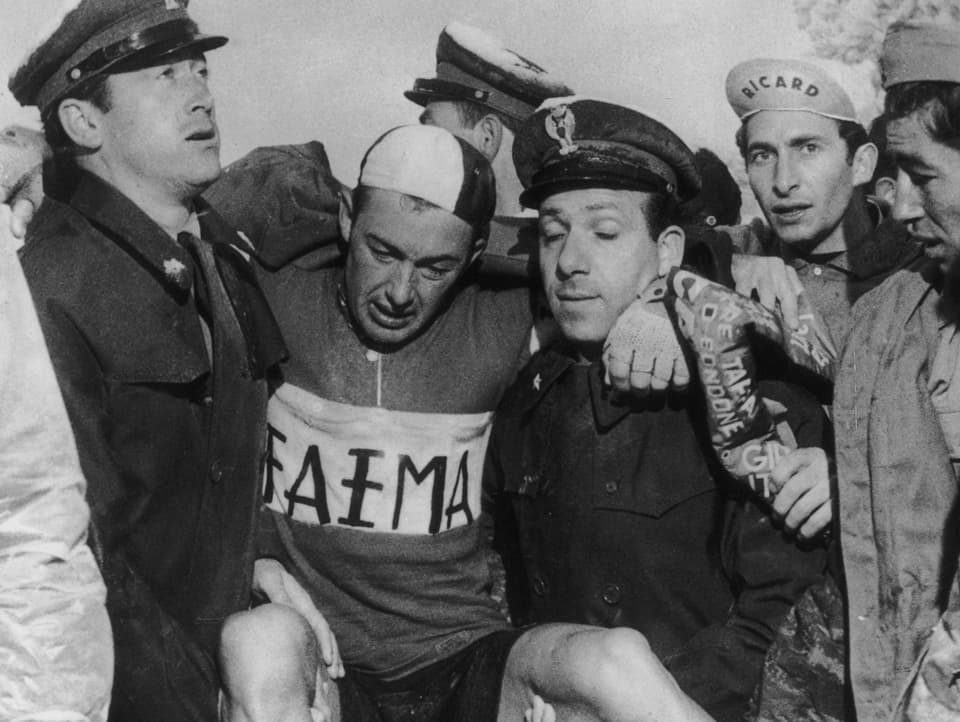The 20th stage of Giro d'Italia 1956 is widely regarded for one of the most grueling ones in the annals of professional cycling. Monte Bondone in the Dolomites revealed its most merciless side amidst apocalyptic conditions. The mountain, already known for its challenging terrain, became the setting for one of the most brutal and unforgiving stages in cycling history, where riders faced not only the grueling ascent but also a battle against the extreme forces of nature.
The day of the Monte Bondone stage, June 8, 1956, started with ominous weather forecasts.
Riders were warned of rain, plunging temperatures, and the possibility of snow as they climbed higher into the mountains.
Many team managers and riders voiced their concerns to Torriani, urging him to cancel or at least shorten the stage. The weather forecast was grim, and the prospect of snow in the Dolomites was not to be taken lightly.
Yet, race director Vincenzo Torriani refused to cancel the stage. He was known for his desire to make the Giro a test of human will, and he may have thought that this stage could bring the excitement the race desperately needed. (However, the struggling of Fiorenzo Magni with his broken collarbone has broguht already drama into the rsce.) After all, cycling, particularly stage racing, thrives on drama, and there’s nothing like a battle against nature to turn an ordinary race into a legend. For Torriani, this was an opportunity to craft a story of epic proportions. His decision would soon become the turning point of the Giro d’Italia that year, for better or worse.
As the riders set off, the rain began to fall steadily, quickly soaking their clothes and chilling them to the bone.
Most of the peloton was severely underdressed, unprepared for the plunge in temperature that would follow as they climbed higher and higher toward Monte Bondone.
Initially, the riders maintained a steady pace, trying to stay warm and focused, but soon the weather became an adversary like no other. What started as rain soon turned to sleet, and by the time the riders reached the base of the Monte Bondone climb, the sleet had transformed into heavy snow.
The temperature plummeted, and the roads became slippery and treacherous. Many riders, their bodies shaking from the cold, began to struggle. Breathing became labored in the thin, icy air, and visibility deteriorated as the snowstorm intensified. The riders’ wool jerseys and shorts, now soaked through, offered no protection against the biting cold. They were pedaling into a storm, their hands and feet going numb, the handlebars coated in ice. As the conditions worsened, the number of riders abandoning the race increased dramatically. Of the 89 riders who started the stage, 60 would not finish.
Amidst the chaos, one rider seemed to thrive where others faltered. Charly Gaul, an enigmatic climber from Luxembourg, was known as "The Angel of the Mountains" for his light build and remarkable climbing ability. Coming into the stage, Gaul was sitting in 11th place overall, a respectable position but far from contention for the Maglia Rosa, the leader’s pink jersey.
However, Monte Bondone would change everything for Gaul.
Gaul had a reputation for being somewhat aloof and solitary, often described as a rider who preferred to suffer in silence. He wasn’t part of the cycling elite at that time, but he possessed an extraordinary capacity to endure pain, which would prove to be his greatest asset on that day. Despite the treacherous conditions, Gaul attacked early on the climb, separating himself from the peloton. Some attribute his ability to press on to the amphetamines he was rumored to have taken before the stage—a common practice among cyclists at the time. Whether or not this is true, what is certain is that Gaul's physical and mental resilience were exceptional.
As he ascended the Monte Bondone in freezing temperatures, Gaul’s performance was nothing short of heroic. He pedaled through the snow and wind, his lean figure cutting a lonely silhouette on the desolate, snow-covered road. He was soaked, shivering, and his muscles were near failure, but he pressed on, pulling further and further ahead of his rivals. While other riders were being lifted into cars or carried away from the road, Gaul climbed higher, as if driven by some unseen force.

By the time he crossed the finish line at the top of Monte Bondone, Gaul was utterly spent.
His body was so frozen that he had to be physically lifted off his bike.
The cold had penetrated his very bones, and the race organizers had to cut his jersey off him, as it had frozen stiff. Gaul’s suffering was profound, but so was his victory. He had gained an astonishing 8 minutes and 15 seconds on his nearest rival, and this effort catapulted him from 11th place to the top of the general classification. Gaul was now in the pink jersey, a position he would not relinquish for the remainder of the race.
Gaul went on to win the 1956 Giro d’Italia, becoming the first and only Luxembourgish rider to win the race. His victory on Monte Bondone remains one of the greatest moments in cycling history, a testament to the extraordinary mental and physical fortitude required to compete at the highest level of the sport. While his career would have other highs and lows, the events of that fateful day in 1956 would forever define him.
